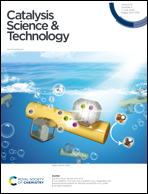Nature and evolution of Pd catalysts supported on activated carbon fibers during the catalytic reduction of bromate in water†
Abstract
Catalytic hydrogenation of bromate using Pd catalysts supported on activated carbon fibers is a smart solution to treat bromate polluted water. These catalysts have been analyzed by different techniques for an in-deep characterization of the active sites. The in situ X-ray absorption spectroscopy and the CO chemisorption studies showed that Pd0 nanoparticles with different crystal sizes were generated on the support during hydrogen activation at 200 °C and that the PdHx-phase was formed during the cooling to room temperature. As PdHx species formed on Pd0 nanoparticles are responsible for bromate reduction, the most active catalysts are those having Pd0 nanoparticles with large crystal sizes, where PdHx species are easily formed. The catalysts are fully stable in succesive reaction runs. It has been also shown that bromate reduction rate depends on the bromate concentration and on the hydrogen partial pressure, with a pseudo-first reaction order towards both reactants.



 Please wait while we load your content...
Please wait while we load your content...